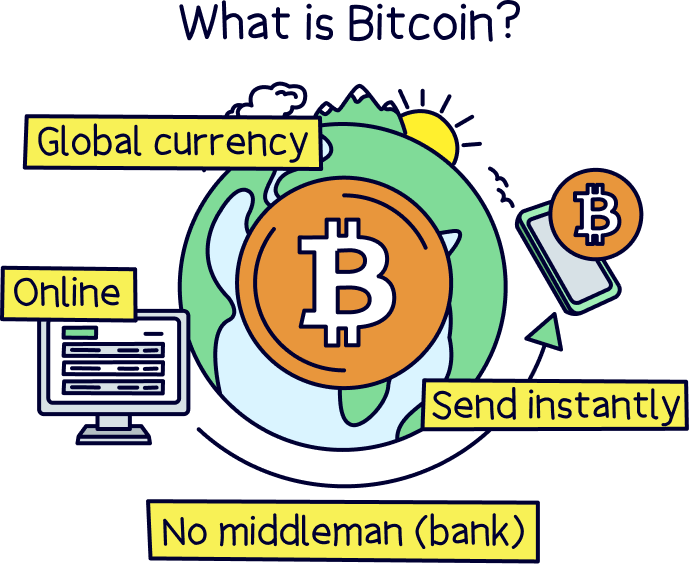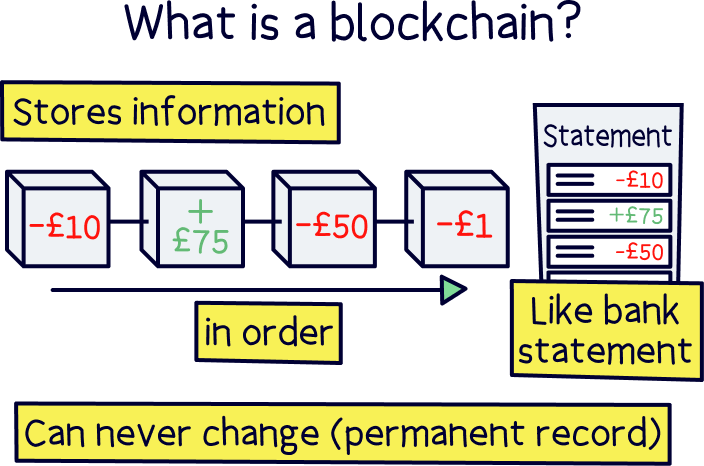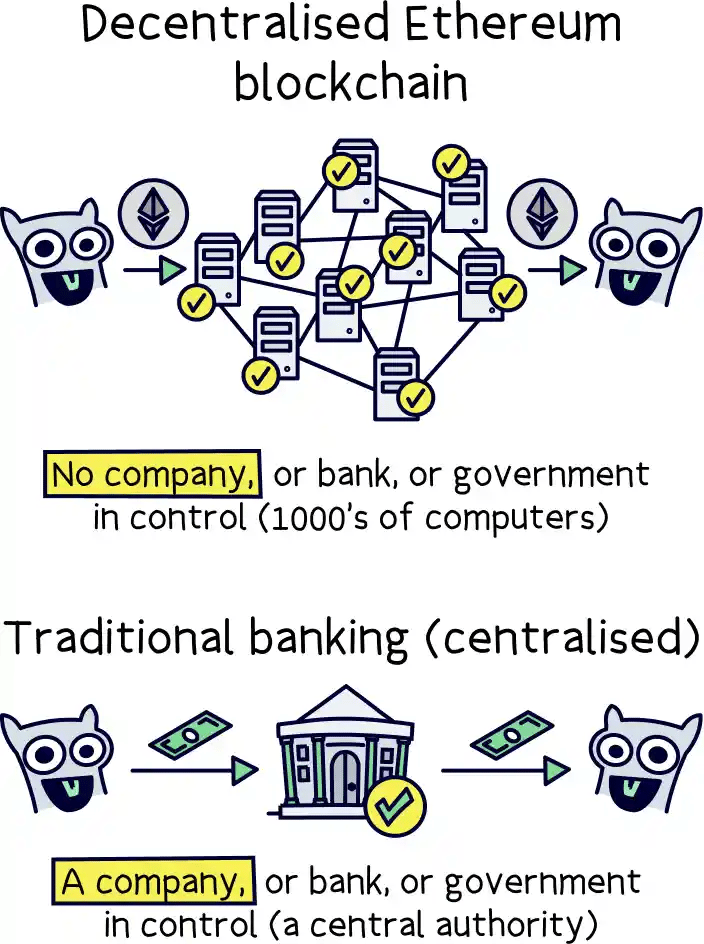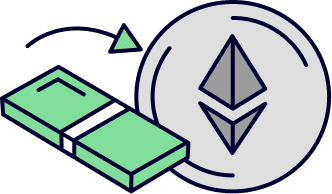
Article contents

Ethereum is a new technology that allows applications (apps) to run automatically without the need for a central authority (e.g. Google or a bank) – so removes the need for trust – the software runs by the rules set. It’s revolutionary and has the potential to change many industries in future, such as finance. It’s exciting stuff!
Heard of Bitcoin and cryptocurrencies, but not sure what Ethereum is? You’re in the right place. We’ll run through the basics of Ethereum in simple and easy to understand steps.
Ethereum is very different to Bitcoin, although they are both classed as cryptocurrencies. Bitcoin is purely a currency (like Pounds), or ‘digital currency’, so you can send bitcoin to your friends and family, or receive bitcoin, and even use it to buy things in the shop.
With Bitcoin, there’s effectively no inflation (where your money becomes less valuable over time) – as the number of bitcoin is fixed (at 21 million), and so it’s also seen a ‘store of value’, similar to gold, which is simply to store your money without it going down in value like traditional currencies (because of inflation). However, the price of bitcoin does change a lot, so a store of value concept is certainly one for the future.
It’s also not controlled by a central authority such as a bank, company or government, so it cannot be mismanaged like local currencies (like the US Dollar, these are also fiat currency). Authorities consistently print lots of new money causing more inflation.
It can be sent directly from person-to-person, (peer-to-peer), so doesn’t need a central authority for it to work, and therefore transactions are very low cost, very quick, and can be made across the globe. It’s money for the 21st century.
We’ve got a whole guide on what is Bitcoin? If you’d like to learn more.

Now back to Ethereum.
Ethereum is different to Bitcoin, it’s a technology to build software applications on (decentralised applications or Dapps) – think of it like your mobile phone with various different apps on it. Ethereum is the phone. Well, it’s the operating system on the phone – the technology for other people and businesses to build apps on top of.
And these apps can be a wide range of things that want to use blockchain technology. They can range from finance, to games, all the way to healthcare. (we’ll cover what blockchain is below.)
The benefit for these apps is there is no central authority (such as a company or government) to control how things should operate, or how transactions should happen. For instance, if you transfer money to your friend through your bank, it is up to your bank how that happens, how much it will cost you, how long it will take, and even if your friend should get the money or not – the bank is a central authority.
With Ethereum (and Bitcoin), you can send money (or make transactions) directly to your friend, without any middle-man or central authority. It’s quicker, cheaper, more secure and more private. Plus, you can guarantee the transaction will be made, there is no government or company to stop or block it.
And in terms of your own data, you are in full control, whichever app you use. It all links to one Ethereum ‘account’, which you own, and you decide what data you’d like to share. (We’ll cover this in more detail later.)
As a quick example, instead of using Bitcoin to transfer money to a friend. On Ethereum, you can actually send Pounds, Dollars and various other local currencies to your friend instead.
You can swap your real life Pounds, for a token (called a stablecoin) on the Ethereum blockchain that represents a Pound, send the token to your friend, and they can swap it back to real Pounds if they want to. Pretty cool right?
You’ve just sent it directly to your friend with no bank involved, in seconds, and for a very low cost – they can be in any country across the world, and you don’t need a UK bank account – imagine the bank fees saved!
The possibilities are endless, interesting right? It’s a completely new technology and we’re still in the very early days. Who knows what applications people might build that could potentially change the world.
Bitpanda is a hugely popular crypto broker, with a wide range of coins, top grade security and great features.
If you’re interested in how Ethereum came about, it was launched in 2015 by Vitalik Buterin, after discovering blockchain technology when using Bitcoin. And is run by the Ethereum Foundation, a non-profit organisation.
Ethereum has since gone on to be the network to launch thousands of new cryptocurrencies that all run on the Ethereum blockchain – some are very serious and useful (including helping science and researching diseases) some are just for fun, such as DogeCoin.
Cryptocurrencies is the generic term, but it’s probably better to think of things as a computer system that can have a token, and this token can store data, be exchanged and sometimes bought and sold.
Ethereum runs on the same technology as Bitcoin, which is on a blockchain – although they have their own different blockchains. A blockchain is effectively a database that stores transactions (also called a ledger), and these transactions can never be altered or changed, only new transactions can be added.
A transaction is simply sending the cryptocurrency, also called a coin, or token, to someone else on the blockchain – and each transaction can also store data. (It’s a bit more complicated than that, but we’re trying to make it as simple as possible.)

The blockchain works by grouping transactions that happen at a similar time into a block, and then that block is added to an ever growing chain of blocks, and this is permanently stored forever. This happens every 6.4 minutes on the Ethereum blockchain, and it’s actually called an epoch, and actually contains 32 blocks (or slots).
Think of it like a bank statement. There’s a long list of transactions that happen in a certain order, which can never change. Except, it’s not owned by your bank, it’s public and can never be edited or deleted.
It works by lots of different computers across the world (called nodes) that process and validate transactions (confirming they are correct) – there’s thousands of nodes across the world! This is how Ethereum and blockchains are decentralised. And means it’s super secure – it’s a network rather than a single computer (server) running everything.

To confirm transactions as correct and in the right order, the nodes will also have validators. This is where you deposit your own money as a guarantee that the information your system is providing to the network is accurate, which is called ‘proof of stake’. And each validator will earn a small reward every time a new block is added to the blockchain.
This is different to ‘proof of work’, which Bitcoin uses, where no ‘stake’ (money) is needed to prove transactions are accurate – it uses energy instead. And each bitcoin miner (the computer) will work out a complex maths problem in order to propose a new block (whoever does it first, proposes the block, and all the rest confirm it to be true/correct).
The Ethereum blockchain is public and viewable by anyone, and more importantly, software can read it in order for apps to operate. This is a good thing, and means transactions are completely transparent (for instance, donations to a charity). Although that doesn’t mean it’s not private – everything is anonymous (unless you want to be public).
There is more privacy for transactions if it requires it. Here’s where it gets even more complicated, other blockchains can run on the Ethereum blockchain.
These are called ‘layer 2’s (Ethereum is layer 1), and these layer 2s can make transactions and then they’re all bundled together into one single transaction on the Ethereum blockchain. We won’t go into this now, but the technology is evolving rapidly and creating lots of new possibilities for future applications to use.
Ethereum is actually the name for the blockchain (the network) and the technology itself. The tokens that Ethereum uses is called ‘ether’ and is Ethereum’s native cryptocurrency. And it’s this ether that people are actually using to run their applications, exchange and buy and sell.
To make a transaction, such as when using an application, or sending tokens to your friends, you must pay a small transaction fee in ether. This is called a ‘gas’ fee, and is deducted when you send the token. The higher the gas fee you set, the faster the transaction can happen.
On a crypto exchange (a place to buy and sell cryptocurrencies), this is represented as ETH. Which is the ticker symbol investors use. It’s similar to a stock exchange, where Apple would be represented as AAPL.
On the Ethereum blockchain, alongside the ether token, there are also thousands of other tokens, all related to different projects and applications. The technical name for these tokens is ERC-20 tokens.
You may have heard of non-fungible tokens, or NFTs, and these were originally created on the ethereum platform. They are effectively ownership (you own it) of a digital asset that is provable by the blockchain (an asset can be effectively anything, for instance digital art is very popular).
There can only be one ethereum address that owns an asset, and therefore using a blockchain can prove that an individual owns an asset because they own that address with their wallet (more on wallets below).
Applications on Ethereum use smart contracts, this is when the application, or program carries out something it is supposed to do when a certain event occurs. So, there’s no human interaction at all. For instance, you might have a lottery application that picks a random ticket holder every week and automatically pays them the winnings straight away – all carried out by the smart contract code.
Smart contracts are similar to a normal contract you might use all the time in the ‘real world’. For instance, you have a phone contract where you agree to pay a fee every month for your phone. Or, you might have a contract to carry out some work. With smart contracts, the concept is exactly the same, except it’s digital and managed by computers.
These were simple examples, and these can get incredibly complicated. For instance, there’s lots of contracts in traditional finance, such as buying and selling investments or exchanging money – and so Ethereum smart contracts are a great replacement to increase efficiency and remove the need to trust a company to handle things for you. This is called decentralised finance or DeFi.
Ethereum software is all open source, meaning you can view the code, and copy it if you want to (sometimes called a hard fork). And the app software itself runs on the ‘Ethereum Virtual Machine’ (EVM) – which is similar to an operating system like your computer has to run apps.
Smart contracts are why Ethereum is so exciting, who knows what might be created in future. We’re geeking out a bit now!
You might have heard of Ethereum 2.0, this isn’t actually a thing anymore. This was in relation to a major upgrade to the Ethereum network, called ‘the merge’ and was completed successfully.
It was moving from proof-of-work, which uses miners (computers) to process transactions, similar to Bitcoin, to proof-of-stake, which uses money (staking ether) as a deposit to process transactions (both described above).
Getting technical, the way transactions are processed and validated is called the consensus mechanism (i.e. proof of stake), and the new chain is technically called The Beacon Chain.
So, you don’t have to worry about it, there isn’t really an Ethereum 2.0, it’s still just Ethereum!
When you use Ethereum, you’ll need an Ethereum wallet to store your ether (and other coins or tokens) and then interact with decentralised applications. Think of it as your own account (like an email address), which you’ll use for every application – you don’t need to create new accounts for every app. How great is that?
But it's different to an email address as there’s no username or password, you’ll create a wallet with a private key instead. This is like one long password, and is the only way to recover your wallet if you lose access. So don’t lose it and don't share it with anyone! This makes Ethereum super secure – only you can access your wallet and therefore your money.
Keen to create a wallet? Here’s where to find the right Ethereum wallet for you. Although most people use MetaMask.
Keen to get involved with Ethereum and buy some ether? It’s a lot simpler than the technology described above! Here’s how.

All you need to do is head over to a cryptocurrency exchange, that’s a website or an app where you can buy and sell crypto. It’s similar to a stock exchange, where you would buy and sell stocks and shares of companies.
You then deposit your Pounds, and swap it for ETH or ethereum – just hit buy! The exchange will handle the rest, and you’ll end up ethereum (ether) in your account. As simple as that.
The hard bit is finding the right crypto exchange for you as some are hard to use, and some are expensive. We've done that bit for you – here’s the best crypto exchanges in the UK.



Bitpanda is a hugely popular crypto broker, particularly in Europe, where it’s one of the largest crypto platforms, and still growing - it has more than 7,000,000 customers worldwide. In the UK, it offers access to over 600 cryptocurrencies, with no deposit or withdrawal fees. Bitpanda was founded in 2014 in Europe (Austria), which is old for crypto!
You might have heard of them as they’ve sponsored PSG, AC Milan and Bayern Munich football teams, alongside the Davis Cup tennis tournament and the World Padel Tour.
Bitpanda is suited to pretty much every type of crypto investor, from those just getting started and looking to buy and hold assets such as bitcoin, all the way to advanced traders looking for a secure and reliable platform.
Trading is available 24/7, and there’s industry leading security to ensure your account and crypto are secure.

For beginners, it’s accessible, and there’s a wide range of help articles to get started and learn about investing and the platform itself. And you can get started with just £10.
Fees wise, it’s reasonable. There’s no fees to deposit or withdraw money, or to hold crypto within your account. You’ll pay a fee when you buy or sell crypto, and this ranges from 0.99% to 2.49% depending on which crypto you are buying (lower for the more popular coins such as bitcoin).
You can earn rewards on your crypto too (called staking), all within the Bitpanda platform.
The customer support is good, with a large help centre that covers most common questions and a support ticket system where you can email in for specific issues, with great service and feedback.
Overall, it’s a great platform, and well worth checking out.
Account fee: free
Dealing fee: from 0.99% to 2.49% per trade
Currency conversion fee: n/a
Deposit or withdrawal fees: n/a



Uphold is super easy to buy and store crypto. It's one of the easiest places out there, and the mobile app is great.
It's very popular in the UK, Europe, USA and across the world, with over 10 million customers. And, it’s also one of the safest platforms out there.
The range of coins is good (over 250), and you can store local currencies too (e.g. Pounds, Euros, Dollars).
You can also open a business account (if you have a company).

Popularity: popular
Mobile app: Yes (Apple and Android)
Crypto wallet: yes
Fees: high
Minimum deposit: £1



eToro is one of the most popular places to buy assets like crypto (including ethereum), stocks and shares, and more.
Their website and app is easy to use.
Plus it’s easy to view your performance, buy or trade other cryptocurrencies and sell if you decide to.

One of the best features, exclusive to eToro, is allowing you to follow other investors, learn from them and even copy their trades.
Popularity: extremely popular
Mobile app: yes (Apple and Android)
Crypto wallet: yes
Fees: medium-high
Minimum deposit: $50
Bitpanda is a hugely popular crypto broker, with a wide range of coins, top grade security and great features.
After that, you can leave it where it is if you want, and let the exchange look after it. Or, you can send it to your Ethereum wallet, which gives you full control over it and is generally safer. In your wallet you can either keep it there, or use it to interact with Dapps (decentralised apps).
If you want a more step-by-step guide, here’s how to buy ethereum in the UK, and if you’re interested in Bitcoin, here’s how to buy bitcoin in the UK.
Note: there is another Ethereum token called ‘ethereum classic’ or ‘ETC’. This is not the same. It is an older version that is effectively not in use anymore but you can still buy it.
We hope that made some sense, and you now understand Ethereum a bit more! It’s a very complicated topic – it’s a new technology after all. It’s constantly evolving too, with lots of software engineers working hard to improve it.
The best way to learn more is to simply get involved. Buy some ether, set up a wallet and have a play around – you’ll be familiar in no time! As a recap, the best way to buy ether is on an exchange, and here’s the best crypto exchanges.
There’s also lots more to learn on the Ethereum website.
Bitpanda is a hugely popular crypto broker, with a wide range of coins, top grade security and great features.
Bitpanda is a hugely popular crypto broker, with a wide range of coins, top grade security and great features.
We’d love to hear from you, and it will help others too.
Bitpanda is a hugely popular crypto broker, with a wide range of coins, top grade security and great features.